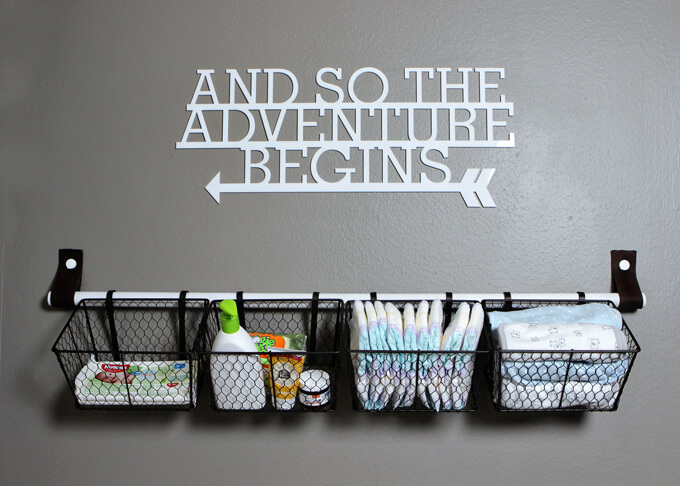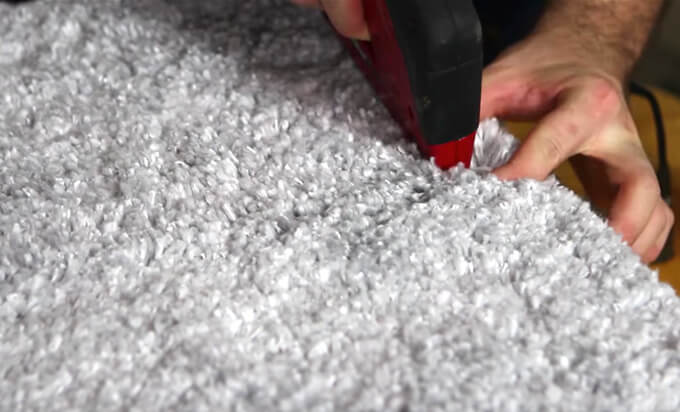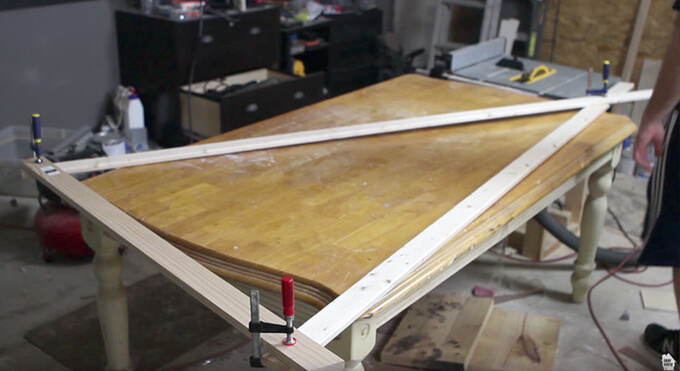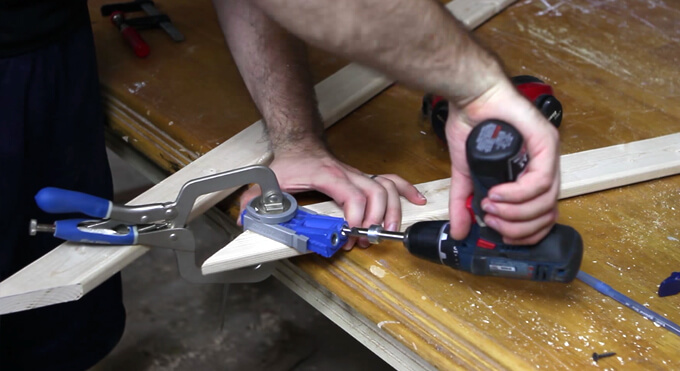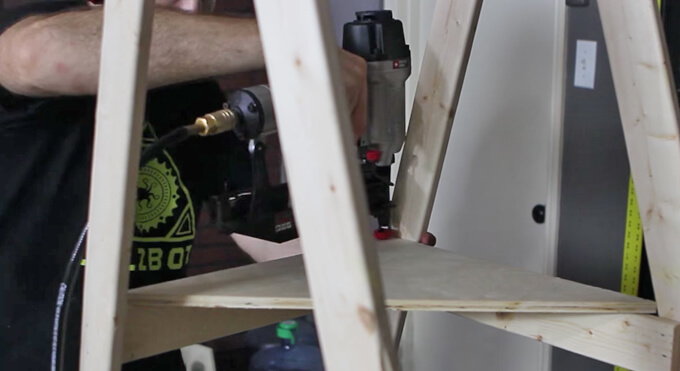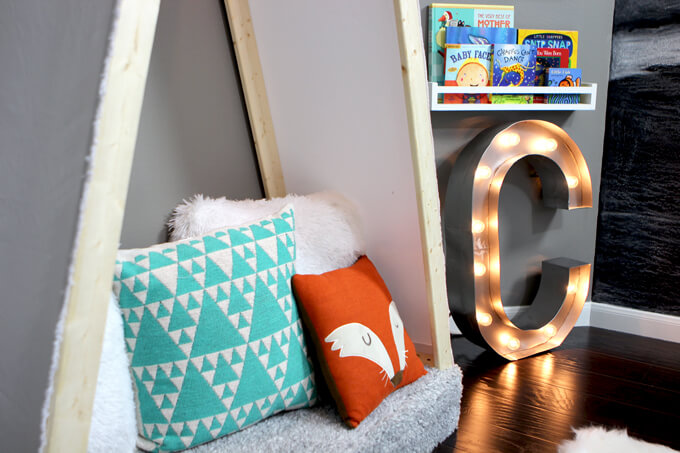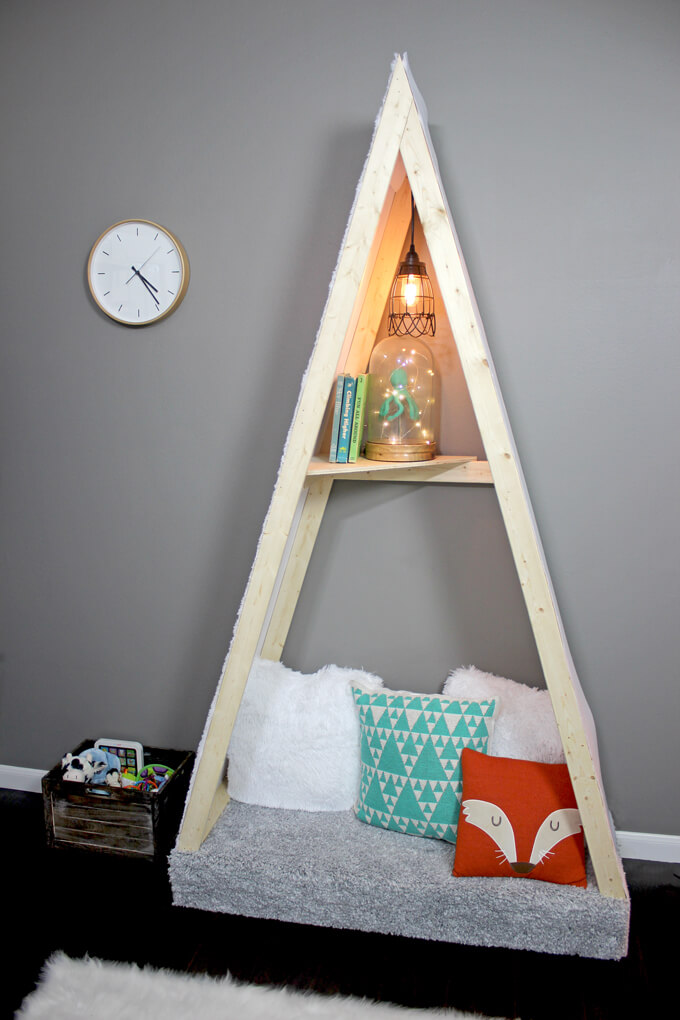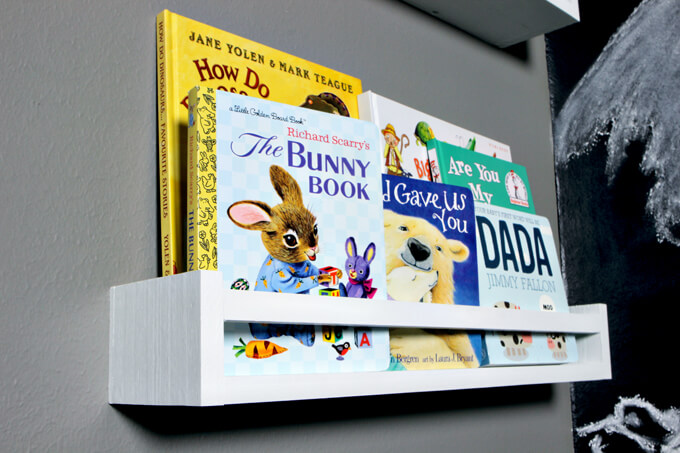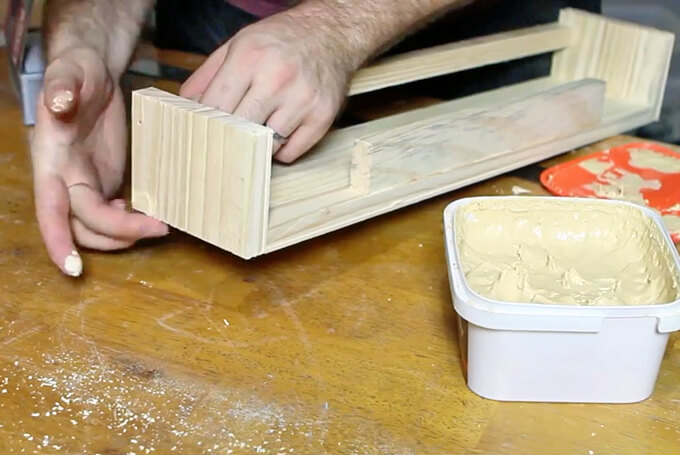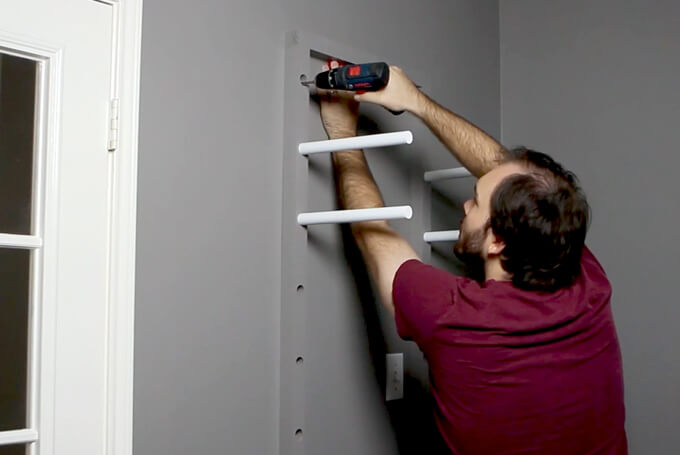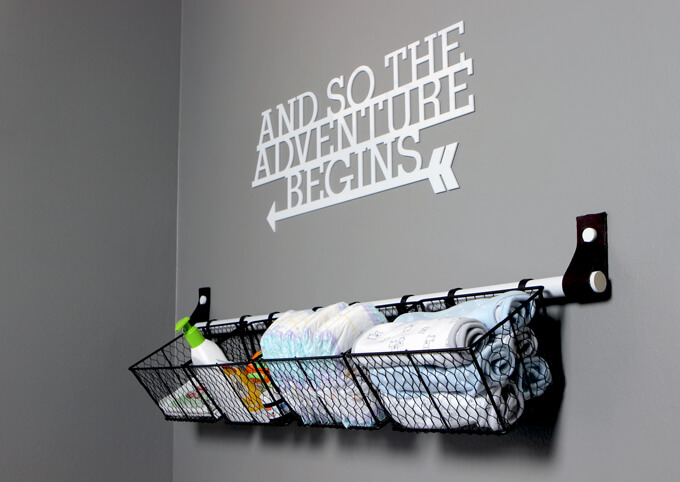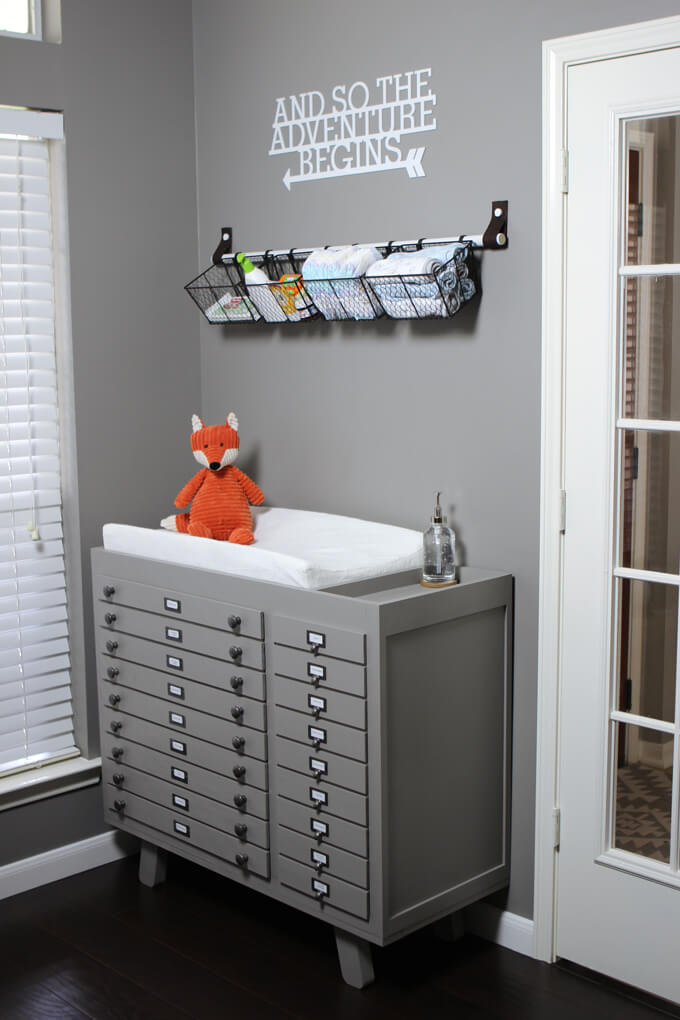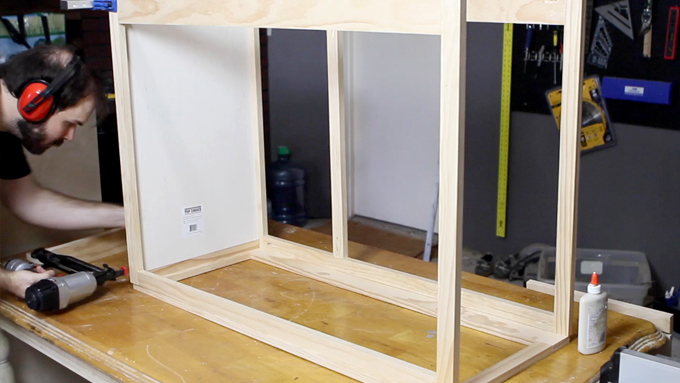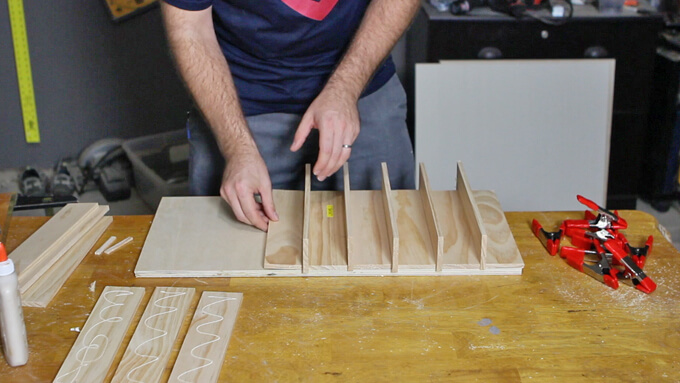Take a tour of our son’s modern outdoor themed nursery. Complete with a hand drawn chalkboard wall and whimsical woodland watercolor prints. Our woodland nursery design features mountains and black, white, and gray nursery elements. We designed a monochromatic nursery that is a gender neutral nursery perfect for a child who loves exploring the outdoors.

We are excited to finally reveal our son’s modern outdoor themed nursery.
All of the DIY projects we had planned are finished and it came together exactly how we had imagined, maybe even better.

Before we began our modern outdoor themed nursery makeover, the room was a blank canvas.

We had big plans for the room but didn’t get started working on it until the end of July. Luckily, our son stayed put until a week past his due date so we were able to get everything done, just in time for his arrival.

When we found out we were having a boy, Brent and I started brainstorming what we wanted his nursery to look like.
We were on the same page wanting it to be an outdoor themed nursery that wasn’t too cutesy or too rustic. Our vision was to design a modern outdoor nurser.
We liked the idea of a neutral color scheme so this theme is gender neutral.
We incorporated woodland animals into the room as well through the wall art and pillows.
Modern Outdoor Themed Nursery Details

First we made some large changes to the room. We painted the walls gray and replaced the doorknobs. We also pulled up the carpet and installed laminate flooring. The flooring project took a few weeks to complete and turned out to be a labor intensive process due to the uneven concrete below the carpet. Thanks goodness I was pregnant and had a good excuse to get out of that one!
To add privacy to the room Brent put decorative window film on the glass panes in the doors.
After our son was born, we quickly learned middle of the night diaper changes are a bit difficult in the dark. To solve this issue we added a huge light bulb over the changing table. It is perfect because it is just bright enough to see what you are doing without blinding you when you are half asleep at 2:00 in the morning. Plus, it is a crazy giant light bulb which makes it a fun addition to the room.

The room was dark because we replaced the old light fixture in the room with a two-blade ceiling fan. We chose this particular ceiling fan because it resembled a plane propeller.

I feel like our biggest challenge was making sure we were keeping a cohesive look throughout the whole room. With each DIY project we started and each new decorative piece we added to the outdoor themed nursery, we spent a lot of time beforehand planning and probably over analyzing.

We wanted to make sure all the elements fit the aesthetic we were going for, matched the other pieces in the room but weren’t too “matchy-matchy”. Like I said, we probably totally over analyzed our kid’s room but we love the end result. It turned out looking clean but still fun and whimsical.
2 YEARS LATER UPDATE: I’ll go ahead and read your mind and put it at ease and let you know, yes, we removed the fragile vase and the giant marquee light and moved it up high once he was mobile.
 Shop Gray House Kids Woodland Nursery Prints
Shop Gray House Kids Woodland Nursery Prints
Mountain Scene Chalk Mural

We love a good focal wall so we decided for our outdoor themed nursery we would try a chalkboard art wall. My dad was kind enough to lend his time and talent to paint the wall with chalkboard paint.
He is really good at painting lines freehand and the thought of trying to paint the lines that separated the gray wall and black wall scared me!
Then, Brent being the crazy talented artist that he is, drew the mountains and landscape scene in chalk.
Wondering if this chalkboard is still intact now that we have a toddler on our hands? Yep! It still looks as good as the day Brent finished it. I don’t know if it is because the crib is in front of it or what but our son has shown no interest in trying to wipe away his dad’s art.
DIY Nursery Camera Mobile

For this simple DIY project, we killed two birds with one stone. We made a playful mobile using a wood slice and felt pieces and hid our nursery camera in the wood slice so we can watch our son sleeping but don’t have a bulky camera out in the open.
↠ See how we made our nursery camera mobile.
DIY Rocking Chair

We could not find a rocking chair in the style and color we liked that was in our price range. Nursery rocking chairs are expensive. To solve this dilemma, we purchased a normal chair in the color and style we liked and Brent removed the old legs. Then he built and attached his own rocking base. It turned out awesome.
↠ See how we made our rocking chair base.
DIY Log Side Table

Our log side table was another “we can’t afford to buy one so we will make one ourselves” project. We found a stump for free and for only $16 and calloused hands, we were able to make our own stump side table that was just the right height to match our rocking chair.
↠ See how we made our log side table.
Custom Designed Changing Table

The baby changing table was a big DIY project but it was worth it to us to have complete control over the design and functionality of this important piece of furniture.
Brent designed this beautiful piece to match our crib but have an old printmakers cabinet vibe as well.
We added labels to give the appearance that camping gear is being stored in the drawers to match with the outdoor themed nursery but the truth is those drawers are fake! They are actually doors hiding all of the diaper changing necessities including a diaper pail.
The changing table is the project in the room that is currently getting the most use for sure.
↠ See how we built our changing table.
DIY Nursery Wall Storage

When you have a newborn it feels like you need to have at least eight arms to successfully do everything you need to do. To make things easier during diaper changing time we created this simple wall storage solution.
We attached a dowel rod to the wall using leather straps and hung baskets filled with diapers, wipes and burp cloths so there is very little effort needed to grab the essentials.
↠ See how we made our nursery wall storage.
Wall Mounted Clothes Rack

The room we are using for the nursery is actually a bonus room so it does not have a closet. We were faced with the challenge of where and how to store baby clothes.
We didn’t want a bulky piece of furniture so we opted not to use a dresser and instead made use of an empty wall by building a vertical baby clothes rack.
2 YEARS LATER UPDATE: Where there were blankets on the bottom shelf there are now toddler shoes and a basket for hats but other than that this piece is still going strong! I love how the limited space forces me to stay on top of his clothes and make sure I only have the size that currently fits folded in the baskets.
↠ See how we built our baby clothes rack.
Simple Bookshelves

These super easy to build bookshelves were the perfect afternoon DIY project. We built them so they would be the exact length to fit on the angled wall and we could store and display all of Connor’s book next to his reading nook.
↠ See how we built our bookshelves.
DIY Reading Nook Tent

The reading nook tent was the last project we built for the room. We wanted to include a playful piece that could be a cozy place for Connor to curl up and read once he gets older. What is an outdoor themed nursery without a tent?
For now we use it as a seat to watch him while he plays on his play mat. We added a few vintage and whimsical decor pieces on the shelf to complete the look.
↠ See how we built our reading nook tent.
The room may look unconventional as far as nurseries go, but we love how our son’s modern outdoor themed nursery turned out. It is fun, clean and cozy and a room we think he can really grow into. We hope to spend a lot of time in this space reading and playing together.
I love turning on the twinkle lights and the little lantern at night when the house is quite and rocking him to sleep. It feels dreamy in this room, like we are transported to another land that is just our own, far out in the middle of nowhere.
Looking for More Woodland Nursery Inspiration?
Check out this whimsical woodland nursery we designed for our nephew!


TAKE ME TO THE WOODLAND THEMED NURSERY: ROOM REVEAL
PIN IT FOR LATER

Check out how we we built our son a kid’s reading nook tent made out of wood and canvas for his modern outdoor nursery.

We have been hard at work making an outdoor modern nursery over the last few months for our baby boy. We wanted to transform the room so that when he gets older he feels like he is being transported to a space of whimsy and adventure that will encourage his imagination to run wild.
One project that Brent and I were really excited about creating was a kid’s reading nook tent that would be a centerpiece in the room.
Even though he is just a newborn and the tent is more of a decor piece right now, we wanted the room to be able to grow with him and create a fun spot he could curl up in and we can read together and play pretend. Because you can’t go on an outdoor adventure without a tent!
Update: This piece turned out to be more special than we had hoped. When our son was one and first learning to walk he pulled himself up onto the base of his wood tent, sat down on it and then stood up and start walking!
How We Built A Kid’s Reading Nook Tent Out of Wood
TUTORIAL VIDEO
[yotuwp type=”videos” id=”44681fFjToU” title=”off” description=”off” player=”width=590&modestbranding=0&showinfo=0″]
Subscribe to our YouTube Channel
Like our video? Please subscribe and help us reach our goal of 100k subscribers.

Follow along below to see how we built a kid sized tent out of wood.
STEPS

1. Brent started the build by constructing the platform. We used a table saw to cut plywood into 6” tall pieces for the sides and braces.

2. He used a square to make sure all the sides were straight before we attached them together.

3. These boards were secured together using wood glue and a nail gun with 1 1/2 inch brad nails.

4. Then he attached the top plywood board measuring 48” wide and 30” deep with wood glue and a nail gun with 1 1/2 inch brad nails.

5. Next, he used a 1/2” round over bit on a router to remove the sharp edges from the corner of the platform.

We found a shag rug (here is a similar one) at Target that was 48” wide which made it perfect for this project. We didn’t even have to cut it.

6. To attach the carpet he parted the bristles and stapled in between them with a staple gun.

7. To find the correct angles of the frame Brent used clamps to attach a 48” piece to the uprights and marked where to cut the boards.
Be sure to measure both upright boards if one is longer than the other then the peak of the tent will be off center. Both of the uprights should be the exact same length.

8. He used a miter saw to cut our boards to be 7ft. tall.

9. To attach the peaks of the frame together Brent used the Kreg Jig Pocket Hole System to make two pocket holes.

10. Then, he drilled in two screws into the pocket holes.

11. After turning both of the frames so the pocket holes faced backwards, he connected them with a 1×3 board using my nail gun.
The frames should be the same depth as the platform. Ours was 20” deep so the top frame measured 20” deep once they were connected with the top board.

12. Brent used the nail gun to attach two additional 1×3 boards at the bottom of each side of the frame.

13. To add some interest to the tent we decided to add a triangle shelf midway up.
To build the shelf Brent attached a back brace and a side brace. Then attached a triangle shelf to the top of the braces with a href=”https://amzn.to/2Je7qwY” target=”_blank”>wood glue and a nail gun.

14. After moving the frame into the room, Brent attached the canvas fabric to the sides.
He used the factory edge of the canvas on the front side of the frame and used a staple gun to attach it to the frame in 6” intervals.

15. Then Brent attached and concealed the not so great looking side on the back.

16. The entire frame was attached to the base using a drill and 2” drywall screws.

We picked some quirky elements to decorate the kid’s tent.

We picked out this octopus sculpture in a glass dome and spray painted it turquoise and added string lights to up the whimsy factor.

To make it cozy we picked up several pillows to add variety in color and texture to our kid’s reading nook tent. The fox pillow is my favorite.

How fun is this marquee letter? This huge “C” is for Connor. We wrapped the white branches with more of the LED string lights to add a little magical touch to the reading nook area.
Once Connor is able to start being mobile, we will have to move these items to higher ground, but for now they fill up this space next to the tent nicely and add a playful touch.


While our son might not be able to read for awhile, Brent and I are ourselves are looking forward to sitting in the space, holding him and reading to him.

PIN IT FOR LATER

We made a set of nursery bookshelves to store, organize and display baby books.

Well, it looks like we are actually going to finish this nursery before baby makes his arrival! It didn’t seem like we were going to make it but he decided to stay put for a little longer and is now four days past his due date which has given us plenty of time to finish all of our last minute projects including the nursery wall storage, baby clothing rack and now our nursery bookshelves. (Plus, we have one more project on the way to share that is AWESOME.)
If you couldn’t already tell by the massive shelves we built in our library, we like to read, a lot. Both Brent and I are looking forward to reading to our son right away, even if he doesn’t understand what we are reading just yet. It was a given we would incorporate bookshelves into the nursery.
The nursery has two small walls that are at an angle so we thought that making bookshelves that ran vertically up the wall would be a good use of space.

A popular trend right now is using the IKEA spice racks for baby books so we took that idea and built our own larger, beefier version so we could fit more books on them and fill up the wall.
To see how we built our nursery bookshelves, check out the video or follow along with the steps below.
How to Make DIY Nursery Bookshelves

Thanks for supporting our small shop this holiday season!
STEPS

CUT THE PIECES FOR THE SHELVES
1. To begin making the nursery bookshelves, first we made all of our cuts using our miter saw. We made the following cuts:
The bottom piece of the shelf: 1”x6” cut 20” long
The two side pieces of the shelf: 1”x6” cut 4” long
The mounting plate on the back of the shelf: 1”x2” cut 10” long
The front rail of the shelf: 1”x1” cut 20” long
Because we were making four shelves we cut multiple of the same pieces at one time to make sure they were all the exact same length. We used a clamp to hold a board to the fence of the saw to make the sure all our cuts were the same.
ASSEMBLE THE SHELVES


2. To assemble the nursery bookshelves, first we used our drill to drill two pilot holes into the back of the bottom piece of the shelf and attached the mounting plate piece with wood glue and 1 ⅝” wood screws to the bottom piece of the shelf.

3. Next, we attached each of the side pieces to the bottom piece with wood glue and 1 ½” finishing nails.

4. Finally, we attached the front rail to the side pieces with wood glue and 1 ½” finishing nails.
We used a scrap 1”x2” to rest the rail on while we nailed it from the side boards with our nail gun.
PAINT THE SHELVES


5. Once all of our nursery bookshelves were assembled, we used wood filler to fill the holes and then painted the shelves with Sherwin-Williams ProClassic® Waterbased Paint in Bright White and a nap roller for a smooth finish.
HANG THE SHELVES


6. Before hanging the shelves, we marked the wall studs with painters tape.
Then we centered each shelf on the wall and made sure it was level (with our level).
Finally, we screwed the shelves into the wall over the studs with 3” screws.

The nursery bookshelves were super simple to build and turned out great. We love filling the nursery bookshelves up with books. We have been receiving books as gifts and it is so fun to add them to the shelves as we start a collection for our baby boy.
PIN FOR LATER

We built a wall-mounted baby clothes rack to hang and store clothes in our nursery to make up for the lack of closet in this room. You can buy the PDF plans for our DIY Baby Clothes Rack in our shop.

You know the proverb, “necessity is the mother of invention”? Well, Brent and I found ourselves needing to apply this saying to our baby clothes storage situation in the nursery.
The problem: The nursery does not have a closet therefore there was no designated space to store and organize baby clothes.
I can’t tell you how many hours I would sit in the nursery and just stare at the wall we designated for clothes storage and try and brainstorm ideas for how to store the clothes.
I was frustrated because I knew I wanted something specific, I just didn’t know what that something was.
We could have used a dresser but with the crib, changing table and a wood reading nook tent we are building, we didn’t have room for anymore large furniture.
I spent hours searching for ideas everywhere but everything I could find would take up too much floor real estate.
I had two criteria in mind: I didn’t want it to take up a lot of space and I wanted it to look like a display you would see in a store since the clothes were going to be out in the open and not behind closet doors.

Then, I came across an image of dowel rods holding a sack of potatoes and a light bulb went off. Seriously, inspiration can come from the strangest of places.
Since starting Gray House Studio I have come a long way in my ability to visualize designs and concepts and the fact that I could see a baby clothes rack from this idea makes me pretty proud.
I explained my vision to Brent and he executed my idea perfectly and even threw in a few other great suggestions because he is awesome like that and thus our wall-mounted baby clothes rack was made!

On the top dowel rods are hanging shirts, pants and some of my favorite onesies.
I ordered wood hangers to make it look more like a display. Plus, is there anything cuter than baby wood hangers? They are so tiny!
We purchased these metal wire baskets from Target.
We bought them first so we could build the width of the baby clothes rack frame around them so they would fit perfectly.
They had gold handles which were not the style we were going for and would not hang on the dowel rods anyway so Brent removed them.

Brent had the great idea to create leather straps out of some leather scraps to hang the baskets on the dowel rods. This worked really well and tied the look to the nursery wall storage bar on the opposite wall.

We added a shelf at the top to add a few decor items. I stole the fox artwork from the gym shelves but it fits with this room better anyway because we are incorporating little foxes here and there throughout the room.
To see how we built our baby clothes rack, check out the video or follow along with the steps below.
How We Made Our Baby Clothes Rack
PROJECT PLANS

Get our Baby Clothes Rack Plans
When you purchase our DIY wood baby clothes rack plans you get a PDF with a detailed materials list, a cut list, exact dimensions for each piece, building instructions – all for only $7. We appreciate you supporting Gray House Studio!
STEPS

1 To start the baby clothes rack, we used our miter saw to cut two pine 2×2”s into four pieces. Two long pieces for the sides of the rack and two short pieces for the top and bottom of the rack.

2 On the two side pieces we used a framing square to make marks six inches apart where we needed to make the holes for our dowel rods.
We used a drill press with a 1” forstner bit to drill the holes in the side pieces but stopped each hole ¼” shy of going all the way through the board.

3 Next, we attached the four pieces of the frame together using wood glue and 1 ½” finishing nails.

4 To provide extra strength and support, we came back and drilled pilot holes and secured the pieces of the frame together using 3” decking screws.

5 Once the frame was assembled we took our two dowel rods and cut them down to 12” pieces using the miter saw.

6 We used a roller to paint the frame of the baby clothes rack with Sherwin-Williams ProClassic® waterbased paint in Dovetail, the same color as the wall in the nursery.
We used a smaller paintbrush to paint in the holes of the frame.

7 Then we painted all the dowel rods with Sherwin-Williams ProClassic® waterbased paint in Bright White with a smaller paintbrush.

8 We inserted the dowel rods into the holes of the clothes rack frame with a few taps of a rubber mallet.

9 We installed the frame in the nursery by using a drill to screw the rack into the wall studs and used a level to make sure it was straight on the wall.

10 Finally, we removed the handles that came on the baskets and used embroidery floss to sew 1” wide leather loops out of leather scraps onto the metal baskets so they would hang from the dowel rods.

The metal baskets work really well.
They are the perfect depth for storing lots of onesies, hats, socks, etc. and are really easy to grab but still look nice and organized.

I purchased wood baby hangers because I thought wood hangers would look nicer out in the open.

We will probably store shoes on the bottom shelf once he has shoes but for now it is holding extra blankets.
I love all of the nursery projects we have made so far but the baby clothes rack is definitely one of my favorites because I think it is unique and Brent really made my idea come to life.
By being vertical and hanging on the wall it takes up no floor space but has plenty of storage space to keep baby clothes organized.
Plus, it looks nice enough to be out in the open displaying clothes.
PIN IT FOR LATER

We used a dowel rod, scraps of leather, and a few baskets to create a simple nursery wall storage above the changing table in the nursery.

Last week we shared the baby changing table that Brent built for the nursery.
This week we are sharing another project we worked on, a nursery wall storage solution to go above the changing table that turned out to be really simple to put together and cost us next to nothing to make!
The changing table offers plenty of space to store and organize baby supplies but I liked the idea of incorporating a way to store frequently used baby items, like diapers, so they are easy to grab in a second, right at arms length.

We ultimately decided to keep it simple and make a bar where we could hang a few wire baskets with supplies as a diaper storage solution.
We decided to use a dowel rod that we could spray paint white to match the vertical bars on the crib.
To mount the bar to the wall, Brent came up with the idea to make straps out of leather we already had leftover from another project to hold the dowel rod and match the leather straps on the baby clothes rack.
We bought two sets of these baskets from Kohl’s. They originally came with a different type of bar.

UPDATE: Now that we have a wiggly four month old, this nursery wall storage above the changing table has made our lives a thousand times easier. I can grab the supplies I need quickly from the baskets while keeping a hand on him at all times.

Follow along with the video and steps below to see how to easily make this nursery wall storage project.
How We Made Our Nursery Wall Storage
STEPS

1. To begin the nursery wall storage project, we started by cutting the 1″ dowel rod on the miter saw to match the width of the changing table.

2. To make painting the dowel rod easier, we hung it from the garage door by attaching a screw in one side. We applied a few coats of white spray paint and then used 150 grit sandpaper to sand the rod and painted a few more coats.

3. Next, we took some leftover leather scraps and cut two strips to use to hang the dowel rod.

4. We measured and marked where we needed to drill the holes to hang the leather straps. Then used our drill to drill two holes into the wall to make inserting the drywall anchors easier.
We marked a hole in the center of the leather pieces and screwed the leather loop into the drywall anchor. We used a hinged screw cover to cover the screw to finish off the look.

5. One the leather straps were in place, we hung the dowel rod from them.

6. To secure the dowel rod to the leather straps, we drilled one 1/2″ screw from the back of each piece of leather into the dowel rod so they would be out of sight.
This just added an extra precaution that the dowel rod would not slip out of the leather straps.
Finally, we hung our wire baskets. They already had hooks attached because they were meant to hang on a different type of bar so we just adjusted the hanger part so they would securely fit around the dowel rod.

After the baskets were nice and secure on the rod, I added items I think we will need to grab often like burp cloths, diapers, lotion, wipes, etc.

To finish up this wall, we hung an adventure sign above the nursery wall storage bar that fits with our modern outdoor nursery theme. I love how all the projects came together for this area of the nursery and how it has a cohesive but non cluttered feel.
I know I (better yet…we) will be spending a lot time standing here changing diapers!
PIN IT FOR LATER

Brent built a baby changing table that has a printmaker cabinet aesthetic but with a modern design to match the crib in the nursery. Behind the doors with faux drawers, we are hiding all the necessary changing table supplies including a diaper pail.

We have somewhere around three weeks (or sooner…eek!) until our little Gray House intern makes his arrival and we have been scrambling to get his nursery ready.
Back in July we thought we had ALL the time in the world to get projects finished but when you are trying to DIY 90% of the nursery and only have the weekends to work on it, time runs out REALLY fast.
We had to start prioritizing our DIY nursery projects and the first and most important project on the list was to build a baby changing table since it is an essential part of the nursery.

When it comes to designing furniture for our home we like to create pieces that fit the aesthetic of the room but are functional as well. For the changing table / cabinet we spent a lot of time focusing on the design.
We really wanted it to match the Hudson crib from Babyletto that my parents gave us so all the large pieces in the nursery would have a cohesive look and feel.
But we also needed it to have plenty of storage space to hide the items we didn’t want sitting out in the open.

We designed the baby changing table to look like a modern printmakers cabinet with the large amount of drawers but they are actually all fake! In reality there are two doors.
Behind the wider door is a shelf with large baskets where we are storing extra diapers, nursing supplies, lotions, burp cloths, etc.

Behind the narrow door is a diaper pail. What is great about custom made pieces is you can build them the exact dimensions to fit the items you need to store, such as a diaper pail. Because really, who wants an unattractive diaper pail out in the open?
The only hiccup can be if you get the measurements for a diaper pail online instead of buying it first and on the website instead of giving the dimensions of the product, they give you the dimensions of the box the product comes (not assembled) in.
But you don’t realize that so you build the entire cabinet around the dimensions of the box the diaper pail comes in only to realize when you go to buy it that it is taller than the website said and therefore will not fit in the custom spot that you built for it.
Luckily, we were able to find a different diaper pail that fit perfectly and will work just fine. That was a close one! Ah! Lesson learned, buy the diaper pail first.
How to Build a Baby Changing Table
TUTORIAL VIDEO
[yotuwp type=”videos” id=”EG9qLCeiuJo” title=”off” description=”off” player=”width=590&modestbranding=0&showinfo=0″]
Subscribe to our YouTube Channel
Like our video? Please subscribe and help us reach our goal of 100k subscribers.
STEPS

1. To start the baby changing table Brent cut the 1″x2″ select pine boards on the miter saw and cut multiple boards at the same time if they needed to be the same length.
He used the table saw to cut the boards to the correct width.

2. Then he cut all the plywood for the project down to size on the table saw.

3. To inset the two side panels made of plywood into the top and bottom rails, he cut a slot in each of the rails the same thickness as the plywood side and 1 inch from the bottom of the rail.

4. To start assembling the baby changing table Brent glued the slotted rails to the plywood sides with wood glue and used clamps to hold the boards together until everything dried.
He used a measuring tape to straighten the rails to the plywood to make sure it was square before he tightened the clamps down.

5. While the two sides dried, he drilled pocket hole screws in the boards using a drill and Kreg Jig that would go together to make up the front and back frames of the baby changing table.

6. Then he glued and screwed the pieces for the front and back frames together.

7. Once the sides and base were put together, he used a nail gun, 1 ½ inch finishing nails and wood glue to assemble the shell of the baby changing table.

8. Since we wanted the legs of the changing table to match our crib, Brent made a paper template of the crib legs and traced the legs onto the boards that would be the legs of the changing table.
Once those pieces were traced, he used a miter saw to cut the angle at the top of the legs so that the legs would mount to the changing table at the same angle.
Since the boards we were using were only ¾ inch thick, and we wanted the legs to be an inch and a half thick, he glued two boards together per leg.
Then he used a router to round off the bottom edges of the legs and then used a sander to prep the legs for paint.

9. Once sanded and ready for paint, Brent attached the legs to the bottom of the changing table with finishing nails.

10. Next, Brent attached the back piece of masonite and the bottom piece of plywood on the inside of the changing table,

11. To support the weight of the top of the cabinet, he attached little blocks of wood inside the changing table.

12. Then, Brent used finishing nails and wood glue to attach the top to the baby changing table.

13. The divider that separates the space between the changing pad and the area to store other items was nailed and glued to the top board.

14. After the main part of the cabinet was assembled, he moved on to the doors and started by cutting each of the slats that would serve as fake drawers on the face of the doors.
By taping all the boards together it was easier to cut all the pieces at once on the miter saw and make sure they were all the exact same length.

15. After all the fake drawer pieces were cut, he glued and clamped the slats to the piece of plywood that was cut to the right size for the door. He did this for both the wide door and the narrow door.

16. Finally, with the baby changing table built, it was time to paint the entire cabinet. We used ProClassic® interior waterbased paint from Sherwin-Williams that was leftover from when we built our office cabinets. The color (Dovetail) matched very closely to our gray crib.
We went back and forth on what color to make the knobs but finally decided to paint them a dark metal color using Rust-Oleum Universal Metallic Dark Steel spray paint.
We also painted the label drawer pulls the same color to match the knobs and sticking with our outdoor theme and just to make it more fun, we labeled the faux drawers with rock climbing and camping gear supplies.

Being pregnant in the 100 degree Houston weather is no fun, I’m just saying. However, Brent argues that building furniture in a 100+ degree garage is no fun either which I can definitely understand because I have been avoiding being in the garage or outside as much as possible this summer (unless I am submerged in a pool).
This has left poor Brent working on building the majority of the nursery projects by himself in the heat.
I really do appreciate his dedication to making our son’s room awesome (this is seriously my favorite room in our home now) and bringing our vision for an outdoor modern nursery to life. He is awesome like that.
PIN IT FOR LATER









 Shop Gray House Kids Woodland Nursery Prints
Shop Gray House Kids Woodland Nursery Prints




